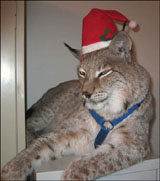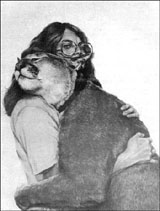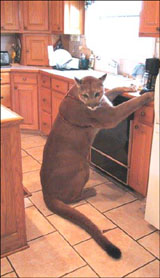
Report from Chris Smith
Large cats could live unnoticed in Buchan admits wildlife expert
By Morag Ledingham in the Buchan Observer, 28 th January 2004
 |
 |
 |
A PETERHEAD man has cast doubt over alleged sightings of the 'Beast of
Buchan' claiming such an encounter would be highly unlikely.
David Witts, who is adviser to the Phoenix Exotic Wildlife
Association, says very few people have seen a live puma under
controlled circumstances with which to compare such sightings of
'puma-like' cats, although he does give credence to the suggestion
that large cats could exist almost unnoticed in the Buchan countryside.
Mr Witts says far from being too big to be a dog, leopards, whether
yellow-orange-tawny or melanistic, average under 100lbs and while
loping on relatively short legs would appear, if anything, to be
smaller than the average Golden Retriever.
"Pumas can be much heavier and tend to walk more 'upright' on longer
legs. In recent times, though, there have been no proven 'black' pumas
anywhere in the world and the 'scream' of a female puma is perhaps
unlikely to go unnoticed in rural Buchan," says Mr Witts.
"As to whether such 'large cats' could exist almost unnoticed given
sufficient food supply, the answer is a qualified 'yes'," he says.
"Indeed, leopards have long had a reputation for doing so. Such a cat
escaped within Nairobi city boundaries in the 1950s, causing
considerable public concern. All attempts to recapture were
unsuccessful, although four other leopards were obtained in the
process, which was news to the local populace."
Mr Witts says such individual 'large cats' could scavenge an existence
in the British countryside for a time, but the question of a breeding
population is another matter altogether.
"Your article implies that recent 'big cat' sightings are the result
of established populations derived from earlier releases; private
collections having been common enough in the late 18th and early 19th
centuries," he says.
"In reality, the latter date is not a terminating point. A private
owner, Sir Gerrard Trywhitt-Drake, helped in the establishment of
zoological gardens at both Edinburgh and Glasgow.
"In the latter half of the 20th century, such owners as James Walton
would take their human-socialised cats for walks in the British
countryside. No member of the public was ever killed or seriously
injured as a result.
"Within the last few years another private owner has provided a good
home for endangered Persian leopards which were formerly neglected at
the second largest zoo in the UK."
Mr Witts says the key date in all of this is 1976, when the "Dangerous
Wild Animals Act" was introduced on the grounds of public interest.
"In theory, this meant that any owner of a listed 'dangerous' animal
(including Geoffroy's cats weighing under 10lbs), simply had to obtain
a license to ensure that checks and controls were put into place.
"In reality, local authorities had the final say as to whether a
licence was granted and, in addition to political forces and ignorance
of subject matter, any possible public safety worries, 'nuisance'
factors, or queries as to whether the applicant or animals'
accommodation was 'suitable' could be used to reject the application."
Mr Witts continues: "Rather than face the possible loss or death of
their animals, a number of private owners inevitably vanished into the
shadows, thus making the situation more problematic than it was
before, with previously legal networking, education measures and
veterinary treatment no longer available.
"This then explains the difficulty in determining whether the current
'alien big cat' phenomenon is as a result of cats released around 1976
having established a breeding population, or more recent releases from
the less capable individuals among the now illegal ownership.
"On a balance of available evidence and probabilities, the latter is
more likely; although most sightings are probably still as a result of
mistaken identification."
Mr Witts says in order to solve the problem, animal welfare and
protection organisations seek to make the existing legislation even
tougher. However, he believes that it would be better to decriminalise
such ownership, or at least provide some form of
amnesty/grandfathering to enable constructive measures to be taken.
"However, given the inevitable media frenzy, political pressures and
public interest groups, in addition to latent tendencies to fear that
which is not familiar - especially
when the 'it' in question has big, sharp pointy teeth - this is
perhaps a pipe dream," says Mr Witts.
"However, in the unlikely event of an 'encounter' without barriers -
whether in Buchan or the Rocky Mountains - remember to follow the
advice given in 'puma country'. Stand tall, facing the cat, keep any
children close to, or behind an adult, prepare to shout, wave arms and
show your teeth if approached closer - do not run, bend down to pick
up ammunition or unpack a camera, or follow the cat into undergrowth.
"Even if the identification of a 'big cat' is not 100 percent certain,
it is recommended to report any such incident to local police for
their consideration and the Scottish Big Cat Trust registered charity
at www.bigcats.org/abc/ for collation of evidence."
Buchan Observer, 28 th January 2003
 |
 |
 |
| Return to index | Return to Scottish Big Cats | Return to Press |